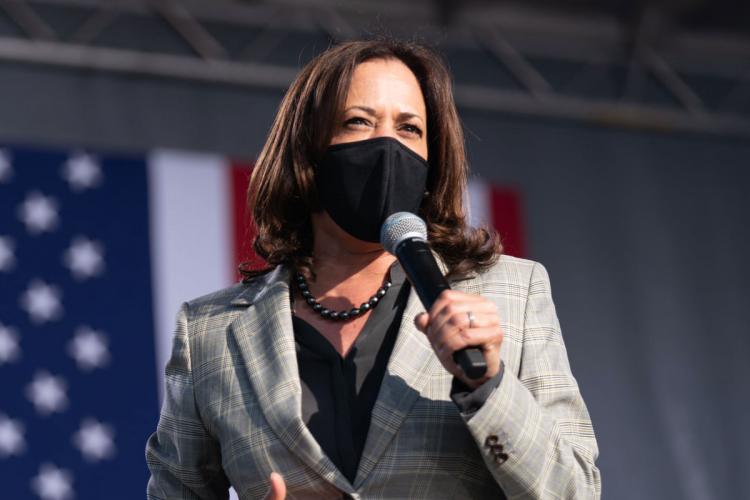Kamala Harris inspires voters in unprecedented election turnout
November 14, 2020
When Joe Biden won Pennsylvania on Saturday, November 7, earning him over 270 electoral votes, Kamala Harris made history as his running mate as she became the first Black, South Asian-American, female vice president-elect of the United States. This exciting, unprecedented moment shared by Harris and the American people brings new hope to an otherwise disheartening year. But what does it mean to have Kamala Harris in the second-highest office in the nation?
To further interpret her past experiences and future impact, it is first essential to understand Kamala’s background. The oldest of the two children, Kamala was born in Oakland, California, to her Indian mother, Shyamala Gopalan, and her Jamaican father, Donald Harris, on October 20, 1964. Kamala’s mother was a renowned breast cancer researcher, and her father was an economics professor. They divorced when she was seven years old, and spent her early childhood growing up in a Berkeley neighborhood. She was influenced predominantly by her mother and the Twenty Third Avenue Church of God, where she and her sister attended services regularly. When mentioning the cultural aspects of her childhood, Kamala remarks, “All my friends were Black, and we got together and cooked Indian food and painted henna on our hands. I never felt uncomfortable with my cultural background.”
At the age of twelve, her mother moved the family to Montreal, Canada, to pursue her research work at Jewish General Hospital. It is there that Kamala finished her middle and high school education, and she graduated from Westmount High School. Her collegiate studies continued back in the United States at Howard University in Washington, D.C., commonly known as a historically Black university. Kamala double-majored in political science and economics before returning to California for law school at Hastings College of Law University, where she studied hard to earn her law degree. She began her career as a deputy district attorney in Alameda County, later transitioning to the Career Criminal Unit’s managing attorney in the San Francisco District Attorney’s Office.
Just two years later, Kamala undertook the role as chief of the Community and Neighborhood Division. Her countless successes as the chief led to her fulfilling the role of San Francisco District Attorney. In November 2010, she assumed the position of California Attorney General and made history as the first woman and the first African American to hold that title.
In 2015, Harris declared her candidacy to fulfill the senate’s seat filled by former member Barbara Boxer. With the promise to increase the minimum wage, allow women the choice of abortion, and create justice reforms, she was an unmatched candidate when she won the seat in 2016. Her many apparent motions as a senator led her to begin her campaign as a candidate for the 2020 election. However, by December of 2019, Harris decided to drop out of the race, though this wouldn’t be her last opportunity during the 2020 election.
As many may recall, on August 11, 2020, presidential candidate Joe Biden announced his choice of Kamala Harris as his vice-presidential running mate. Biden has mentioned her many accomplishments of protecting women, children, and people of color during her years of experience and the many diverse titles she held.
A significant factor that made the 2020 election so substantial was the incredible voter turnout. There is no doubt that Kamala’s historical presence as a woman of color running for vice president contributed to people of color’s commitment to vote in this election. With 150 million people voting, which translates into a turn out of over 66%, this number was the highest in 120 years since the election of 1900. This exceedingly high percentage was due to a majority of people of color exercising their right to vote. In battleground states such as Nevada, Wisconsin, Michigan, Pennsylvania, and Virginia, these votes were particularly crucial for the Democratic party.
When reviewing these integral components of this year’s election, the American people can give credit to both people of color and young voters who supported the ultimate win of Joe Biden and Kamala Harris. According to Insider, “For Black youth, 86% voted for Biden, and 10% voted for Trump. For Asian youth, 83% voted for Biden, and 14% voted for Trump. And for Latino youth, 74% voted for Biden, and 23% voted for Trump.” Without their votes, the election results would be drastically different.
All humans, no matter age, race, or upbringing, need people in their lives to look up too, and for many Americans, this status is fulfilled by Kamala Harris. USA Today quoted Harris’s remarks on the evening of her win, “I’m thinking about my mother, and about the generations of women, black women…Asian, white, Latina, Native American women, who throughout our nation’s history, have paved the way for this moment tonight.” Kamala Harris’s inspiring life story of advocating for others and fighting injustices has energized many Americans and given hope to a new generation of biracial girls. As a role model and politician, Kamala Harris will undoubtedly be incredibly influential and shape America in new, positive ways as Vice President-elect of 2020.
